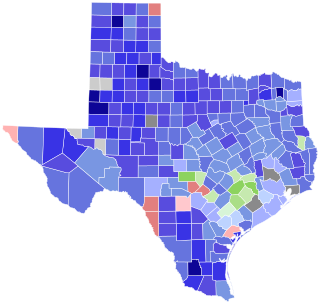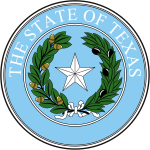
The 1970 United States Senate elections was an election for the United States Senate. It took place on November 3, with the 33 seats of Class 1 contested in regular elections. Special elections were also held to fill vacancies. These races occurred in the middle of Richard Nixon's first term as president. The Democrats lost a net of three seats, while the Republicans and the Conservative Party of New York picked up one net seat each, and former Democrat Harry F. Byrd Jr. was re-elected as an independent.

The 1982 United States House of Representatives elections was an election for the United States House of Representatives held on November 2, 1982, to elect members to serve in the 98th United States Congress. They occurred in the middle of President Ronald Reagan's first term, whose popularity was sinking due to economic conditions under the 1982 recession. The President's Republican Party lost seats in the House, which could be viewed as a response to the President's approval at the time. Unlike most midterm election cycles, the number of seats lost—26 seats to the Democratic Party—was a comparatively large swap. It included most of the seats that had been gained the previous election, cementing the Democratic majority. Coincidentally, the number of seats the Democrats picked up (26), was the exact amount the Republicans would have needed to win the House majority. It was the first election held after the 1980 United States redistricting cycle.

Joseph Draper Sayers was the 22nd governor of Texas from 1899 to 1903. During Sayers's term, the Galveston Hurricane of 1900 demolished that city.

The 1912–13 United States Senate elections were held on various dates in various states. They were the last U.S. Senate elections before the ratification of the Seventeenth Amendment in 1913, establishing direct elections for all Senate seats. Senators had been primarily chosen by state legislatures. Senators were elected over a wide range of time throughout 1912 and 1913, and a seat may have been filled months late or remained vacant due to legislative deadlock. Some states elected their senators directly even before passage of Seventeenth Amendment. Oregon pioneered direct election and experimented with different measures over several years until it succeeded in 1907. Soon after, Nebraska followed suit and laid the foundation for other states to adopt measures reflecting the people's will. By 1912, as many as 29 states elected senators either as nominees of their party's primary or in conjunction with a general election.

The 1944 United States Senate special election in Massachusetts was held on November 7, 1944. Republican Governor Leverett Saltonstall was elected to finish the term of Henry Cabot Lodge Jr., who had resigned from the Senate to serve in World War II.

The 1898 South Dakota gubernatorial election was held on November 8, 1898. Incumbent governor Andrew E. Lee, elected in 1896 as a Populist, he ran for re-election as a Fusion candidate. He was challenged by Republican nominee Kirk G. Phillips, the state treasurer. Lee narrowly defeated Phillips to win his second term as governor, but most of his Fusion allies lost their elections, leaving him as the lone statewide officeholder.

The 1916 United States Senate election in Texas was held on November 7, 1916. Incumbent Democratic U.S. Senator Charles Culberson was re-elected to a fourth term in office. Culberson survived a challenge from former Governor Oscar Colquitt in the Democratic primary, then easily won the general election. He was challenged by Republican Alex W. Atcheson and Socialist Thomas Hickey, publisher of The Rebel.
A Massachusetts general election was held on November 6, 1956, in the Commonwealth of Massachusetts.

The 1892 Texas gubernatorial election was held to elect the Governor of Texas. Incumbent Governor Jim Hogg was re-elected to a second term with a plurality of the vote over George W. Clark, an independent Democrat with the backing of the Republican Party and state railroad interests, and Populist judge T. L. Nugent.

The 1894 Texas gubernatorial election was held to elect the Governor of Texas. Attorney General Charles Culberson was elected Governor with a plurality of the vote over Populist candidate Thomas Nugent.

The 1896 Texas gubernatorial election was held to elect the Governor of Texas. Governor Charles Culberson was re-elected to a second term over Jerome C. Kearby, a Populist running with Republican support.

The 1898 Texas gubernatorial election was held to elect the Governor of Texas. Joseph D. Sayers was elected over Barnett Gibbs, a Populist running with Republican support.

The 1902 Texas gubernatorial election was held to elect the Governor of Texas. S. W. T. Lanham was elected over Republican George W. Burkett in a landslide.

The 1904 Texas gubernatorial election was held to elect the Governor of Texas. Incumbent Governor S. W. T. Lanham was re-elected to a second term over Republican J. G. Lowden.

The 1908 Texas gubernatorial election was held to elect the Governor of Texas. Governor Thomas Mitchell Campbell was re-elected to a second term in office.

The 1932 Texas gubernatorial election was held on November 8, 1932, to elect the Governor of Texas. Democratic nominee and former Governor of Texas Miriam A. Ferguson defeated Republican nominee Orville Bullington.

The 1928 Texas gubernatorial election was held on 6 November 1928 in order to elect the Governor of Texas. Incumbent Democratic Governor Dan Moody won re-election against Republican nominee W. H. Holmes.

The 1920 Texas gubernatorial election was held on 2 November 1920 in order to elect the Governor of Texas. Former Democratic state representative Pat Morris Neff won comfortably in a four-way race against Republican nominee J. G. Culbertson, American Party of Texas nominee T. H. McGregor, and Black and Tan Republican nominee Hickerson Capers.
Lee Lightfoot Rhodes was an American politician who was influential in the Texas state socialist party from its inception until his death in 1936, he served in the Texas House of Representatives from 1895 to 1897 as a Populist.




















